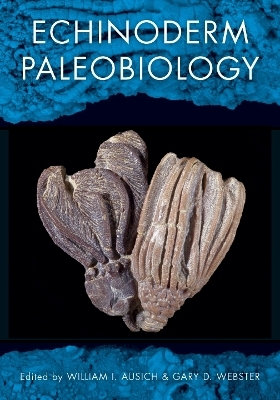
Echinoderm Paleobiology
Indiana University Press (Verlag)
978-0-253-35128-9 (ISBN)
- Lieferbar (Termin unbekannt)
- Versandkostenfrei
- Auch auf Rechnung
- Artikel merken
The dominant faunal elements in shallow Paleozoic oceans, echinoderms are important to understanding these marine ecosystems. Echinoderms (which include such animals as sea stars, crinoids or sea lilies, sea urchins, sand dollars, and sea cucumbers) have left a rich and, for science, extremely useful fossil record. For various reasons, they provide the ideal source for answers to the questions that will help us develop a more complete understanding of global environmental and biodiversity changes. This volume highlights the modern study of fossil echinoderms and is organized into five parts: echinoderm paleoecology, functional morphology, and paleoecology; evolutionary paleoecology; morphology for refined phylogenetic studies; innovative applications of data encoded in echinoderms; and information on new crinoid data sets.
William I. Ausich is Professor of Earth Sciences and Director of the Orton Geological Museum at The Ohio State University. He is an expert in the study of Paleozoic crinoids with an emphasis on paleobiology and evolutionary paleoecology. Gary D. Webster is Adjunct Faculty of Geology at Washington State University.
IContents
Introduction / William I. Ausich and Gary D. Webster
Part 1. Functional Morphology, Paleoecology, and Taphonomy
Introduction to Part 1 / William I. Ausich and Gary D. Webster
1. Taphonomy as an Indicator of Behavior among Fossil Crinoids / Tomasz K. Baumiller, Forest J. Gahn, Hans Hess, and Charles G. Messing
2. Attachment, Facies Distribution, and Life History Strategies in Crinoids from the Upper Ordovician of Kentucky / Carlton E. Brett, Bradley L. Deline, and Patrick I. McLaughlin
3. Paleobiology of Carboniferous Microcrinoids / George D. Sevastopulo
4. The Importance of Echinoids in Late Paleozoic Ecosystems / Chris L. Schneider
5. New Observations on Taphonomy and Paleoecology of Uintacrinus socialis Grinnell (Crinoidea; Upper Cretaceous) / Andrew J. Webber, David L. Meyer, and Clare V. Milsom
6. Taphonomy of the Irregular Echinoid Clypeaster humilis from the Red Sea: Implications for Taxonomic Resolution along Taphonomic Grades / James H. Nebelsick
Part 2. Evolutionary Paleoecology
Introduction to Part 2 / William I. Ausich and Gary D. Webster
7. Tiering History of Early Epifaunal Suspension-Feeding Echinoderms / Stephen Q. Dornbos
8. Evolution and Extinction of a Paleozoic Crinoid Clade: Phylogenetics, Paleogeography, and Environmental Distribution of the Periechocrinids / William I. Ausich and Thomas W. Kammer
Part 3. Morphology for Refined Phylogenetic Studies
Introduction to Part 3 / William I. Ausich and Gary D. Webster
9. Paedomorphosis as an Adaptive Response in Pinnulate Cladid Crinoids from the Burlington Limestone (Mississippian, Osagean) of the Mississippi Valley / Thomas W. Kammer
10. Cladid Crinoid Radial Facets, Brachials, and Arm Appendages: A Terminology Solution for Studies of Lineage, Classification, and Paleoenvironment / Gary D. Webster and Christopher G. Maples
11. The Origin of Lovén's Law in Glyptocystitoid Rhombiferans and Its Bearing on the Plate Homology and Heterochronic Evolution of the Hemicosmitoid Peristomial Border / Colin D. Sumrall
Part 4. Mississippian Impacts and Biomakers
Introduction to Part 4 / William I. Ausich and Gary D. Webster
12. Mixed-Age Echinoderms, Conodonts, and Other Fossils Used to Date a Meteorite Impact, and Implications for Missing Strata in the Type Osagean (Mississippian) in Missouri, USA / James F. Miller, Kevin R. Evans, William I. Ausich, Susan E. Bolyard, George H. Davis, Raymond L. Ethington, Charles W. Rovey II, Charles A. Sandberg, Thomas L. Thompson, and Johnny A. Waters
13. Crinoid Biomarkers (Borden Group, Mississippian): Implications for Phylogeny / Christina E. O'Malley, William I. Ausich, and Yu-Ping Chin
Part 5. Echinoderm Faunal Studies
Introduction to Part 5 / William I. Ausich and Gary D. Webster
14. Overview of Early Ordovician Crinoid Diversity from the Western and Southwestern United States / James Sprinkle, Thomas E. Guensburg, and Forest J. Gahn
15. Ever since Ramsbottom: Silurian Crinoids of the British Isles since 1954 / Stephen K. Donovan, David N. Lewis, Rosanne E. Widdison, and Fiona E. Fearnhead
16. Overview of Paleozoic Stemmed Echinoderms from China / Johnny A. Waters, Sara A. Marcus, Christopher G. Maples, N. Gary Lane, Hongfei Hou, Zhouting Liao, Jinxing Wang, and Lujun Liu
17. Fossil Echinodermata from Puerto Rico / Jorge Vélez-Juarbe and Hernán Santos
Appendices
Index
| Reihe/Serie | Life of the Past |
|---|---|
| Zusatzinfo | 129 b&w photos |
| Verlagsort | Bloomington, IN |
| Sprache | englisch |
| Maße | 178 x 254 mm |
| Gewicht | 1125 g |
| Themenwelt | Naturwissenschaften ► Geowissenschaften ► Mineralogie / Paläontologie |
| ISBN-10 | 0-253-35128-6 / 0253351286 |
| ISBN-13 | 978-0-253-35128-9 / 9780253351289 |
| Zustand | Neuware |
| Haben Sie eine Frage zum Produkt? |
aus dem Bereich


